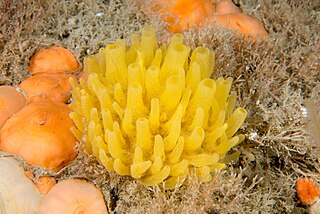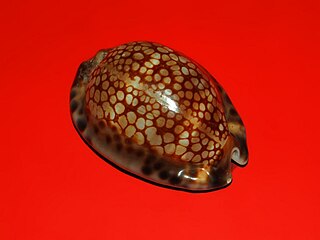
Padina pavonica, commonly known as the peacock's tail, is a small brown alga found in the Indian Ocean, the Pacific Ocean, the Atlantic Ocean and the Mediterranean Sea. It inhabits pools in the littoral zone typically with clayey, silty or sandy sediments. Other habitats include rocks and shell fragments in the shallow sublittoral, seagrass meadows, mangrove roots and coral reefs on tidal flats.

Polymastia is a genus of sea sponges containing about 30 species. These are small to large encrusting or dome-shaped sponges with a smooth surface having many teat-shaped projections (papillae). In areas of strong wave action, this genus does not grow the teat structures, but instead grows in a corrugated form.
Polymastia fusca is a species of sea sponge belonging to the family Polymastiidae. It is found in shallow subtidal habitats in the far north of North Island, New Zealand.
Proteleia tapetum is a species of sea sponge belonging to the family Polymastiidae. It is found in shallow subtidal and intertidal habitats in the far north of North Island, New Zealand.
Polymastia crocea is a species of sea sponge belonging to the family Polymastiidae. It is found in subtidal habitats below 6 m depth in the far north of the North Island of New Zealand.
Polymastia hirsuta is a species of sea sponge belonging to the family Polymastiidae. It is found in various subtidal habitats in the far north of North Island, New Zealand.

Halichondria panicea, commonly known as the breadcrumb sponge, is a species of sea sponge belonging to the family Halichondriidae. This is an abundant sponge of coastal areas of the North Atlantic and the Mediterranean Sea ranging from the intertidal zone to a recorded depth of over 550 m. It is also found in the intertidal zone of the coast of the northern part of the North Island of New Zealand. It is very tolerant of a wide range of coastal habitats, including strong currents, high salinity and exposure to powerful wave action. Its only requirement is a rocky substrate which can include small cobbles.

Porites astreoides, commonly known as mustard hill coral or yellow porites, is a colonial species of stony coral in the family Poritidae.

Clathrina coriacea is a species of calcareous sponge belonging to the class Calcarea and family Clathrinidae. Species in the genus Clathrina are composed of calcium carbonate tube-like skeletons containing spicules. The sponge can be located in shallow waters widely distributed along North Atlantic coasts, as well as on other coasts.

Oreaster reticulatus, commonly known as the red cushion sea star or the West Indian sea star, is a species of marine invertebrate, a starfish in the family Oreasteridae. It is found in shallow water in the western Atlantic Ocean and the Caribbean Sea.

Lyncina lynx, common name : the lynx cowry or eyed cowry, is a species of sea snail, a cowry, a marine gastropod mollusk in the family Cypraeidae, the cowries.

Mauritia maculifera, common name : the blotched cowry or reticulated cowry, is a species of sea snail, a cowry, a marine gastropod mollusk in the family Cypraeidae, the cowries.

Myxilla incrustans is a species of demosponge. It is an encrusting species and is usually yellow.

Cliona viridis, commonly called the green boring sponge, is a species of demosponge in the family Clionaidae. Its form varies according to the nature of the surface on which it grows. In limestone and other calcareous substrates it excavates channels and chambers while on other types of rock it encrusts the surface or forms massive structures. It is native to the eastern Atlantic, the Mediterranean Sea and the Indo-Pacific Ocean.
Corticium candelabrum is a species of sponge in the order Homosclerophorida. It is native to the eastern Atlantic Ocean and the Mediterranean Sea where it inhabits the shallow sublittoral zone. The type locality is the Adriatic Sea.
Biemna variantia is a species of sponge in the family Biemnidae. It is native to the northwestern Atlantic Ocean, the northeastern Atlantic Ocean, the North Sea and the Mediterranean Sea. This species was first described in 1858 by the British naturalist James Scott Bowerbank, who gave it the name Halichondria variantia. It was later moved to the genus Biemna and is the type species of the genus. The type locality is Tenby, Wales.
Hymeniacidon kitchingi is a species of sponge in the class Demospongiae. It is found in shallow waters in the northeastern Atlantic Ocean. This species was first described in 1935 by the British zoologist Maurice Burton. He placed it in a new genus because of its unusual spicules, and named it Rhaphidostyla kitchingi, in honour of Dr J. A. Kitching, who had collected the original specimen. It was later transferred to the genus Hymeniacidon.

Aplysina aerophoba is a species of sponge in the family Aplysinidae. It is a yellow, tube-forming or encrusting sponge and is native to the eastern Atlantic Ocean and the Mediterranean Sea; the type locality is the Adriatic Sea.

Polymastia boletiformis is a species of sponge belonging to the family Polymastiidae. It is found in the Arctic Ocean and on both sides of the North Atlantic Ocean.
Polymastia bouryesnaultae, the knobbly sponge, is a small and cryptic species of demosponge from South Africa and Namibia.










